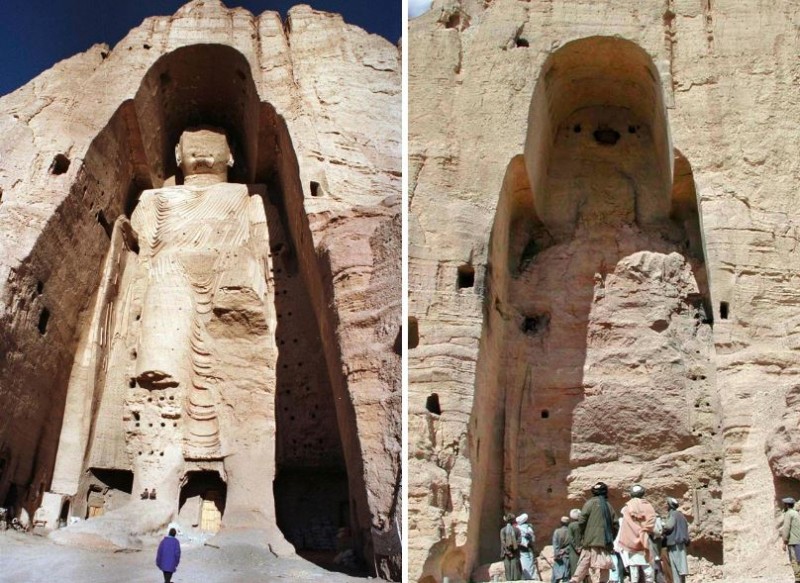
The Bamiyan Valley, nestled in the central highlands of Afghanistan, was once home to two colossal statues of the Buddha, carved into the towering sandstone cliffs. These magnificent statues, known as the Buddha Statues of Bamiyan, stood as a testament to the rich Buddhist heritage of Afghanistan. This article delves into the history of these statues, their creation, the subsequent destruction, and the decline of Buddhism in Afghanistan.
The Creation of the Buddha Statues:
The Buddha statues in Bamiyan were crafted during the height of the Buddhist era in Afghanistan, between the 4th and 6th centuries AD. The Bamiyan Valley, strategically located along the Silk Road, was a prominent center of Buddhist culture and art. These statues, standing at 55 and 38 meters in height, were carved into the cliffs using traditional Gandharan style. The larger statue is believed to represent Vairocana Buddha, while the smaller one likely portrays Sakyamuni Buddha.
The creation of these statues was a monumental undertaking, showcasing the skill and dedication of the artists and craftsmen of the time. The statues were intricately adorned with decorative details, showcasing the artistic finesse of the Buddhist monks and artisans who resided in the region.
History of Buddhism in Afghanistan:
Buddhism first arrived in Afghanistan in the 3rd century BC, introduced during the reign of Emperor Ashoka of the Maurya Dynasty. Over time, it flourished, and Afghanistan became a prominent center of Buddhist learning and culture. Monasteries, stupas, and sculptures were erected throughout the region, contributing to the rich Buddhist heritage.
The Destruction of the Buddha Statues:
The destruction of the Buddha Statues of Bamiyan occurred in early 2001 when Afghanistan was under the control of the Taliban, a fundamentalist Islamic group. In an act that shocked the world, the Taliban, under the leadership of Mullah Mohammed Omar, ordered the dynamiting of the statues. The reasons cited for the destruction were rooted in a strict interpretation of Islamic law that prohibited the veneration of idols and non-Islamic religious symbols.
The Taliban's decision to destroy these irreplaceable cultural and historical treasures was met with international outrage. Numerous efforts were made to dissuade them from carrying out the act, but these pleas fell on deaf ears. On March 11, 2001, the statues were obliterated, leaving behind empty niches and a void in the world's cultural heritage.
The Mentality Behind Breaking Buddha Statues:
The destruction of the Buddha statues was driven by a radical interpretation of Islamic beliefs that considered idol worship and the veneration of non-Islamic symbols as blasphemous. The Taliban believed that the statues' existence was incompatible with their strict interpretation of Islamic law, leading to their decision to demolish them. This act was not only a loss for Afghanistan but also a blow to the shared heritage of humanity.
The Decline of Buddhism in Afghanistan:
The decline of Buddhism in Afghanistan can be attributed to various factors. One significant factor was the gradual spread of Islam, beginning in the 7th century AD. As Islam gained prominence, it led to the conversion of a significant portion of the Afghan population. Additionally, invasions and conflicts in the region, including the arrival of the Huns and the Mongols, resulted in the destruction of Buddhist monasteries and the suppression of Buddhist practices.
The decline of Buddhism in Afghanistan reached its zenith during the medieval period. As a result, many Buddhist sites were abandoned, fell into disrepair, or were repurposed for other religious practices.
The Buddha Statues of Bamiyan stood as remarkable symbols of Afghanistan's rich Buddhist heritage and artistic legacy. Their creation represented a zenith of Buddhist culture and art in the region. However, their destruction by the Taliban in 2001 marked a tragic turning point in Afghanistan's history.
Today, Afghanistan stands as a predominantly Islamic nation, with only remnants of its once-vibrant Buddhist past. The Buddha Statues of Bamiyan, while physically gone, continue to live on in the collective memory of humanity, serving as a poignant reminder of the importance of preserving cultural and historical treasures for future generations.
How Biden Extends US Border Measures and Resumes Venezuelan Deportations!
The US Denies Reports of Worsening India-Canada Diplomatic Face-off
Turkish Military Launches 3rd Air Operation Against PKK in Northern Iraq